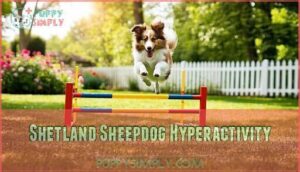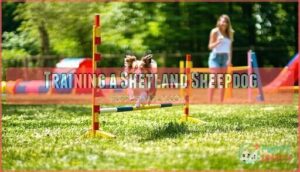This site is supported by our readers. We may earn a commission, at no cost to you, if you purchase through links.

Truth is, these clever herders balance their high spirits with an observant, sensitive side, watching everything before joining the action. If you’ve ever found yourself caught between their quick wits and quick paws, understanding Shetland Sheepdog temperament unlocks the secret to a calmer, happier home.
Table Of Contents
- Key Takeaways
- Shetland Sheepdog Temperament
- Shetland Sheepdog Behavior
- Shetland Sheepdog Hyperactivity
- Shetland Sheepdog Boredom
- Behavioral Problems in Shetland Sheepdogs
- Training a Shetland Sheepdog
- Shetland Sheepdogs and Family
- Shetland Sheepdogs and Children
- Shetland Sheepdogs and Other Pets
- Frequently Asked Questions (FAQs)
- What do you know about Shetland Sheepdogs?
- What is a Sheltie dog?
- Are Shetland Sheepdogs healthy?
- Are Shelties smart dogs?
- Are Shelties good family pets?
- Are Shetland Sheepdogs good house dogs?
- Are Shetland Sheepdogs prone to anxiety when separated from their owners?
- How can I prevent my Shetland Sheepdog from nipping at children and other pets?
- What are some common health problems that Shetland Sheepdogs face?
- What are common health issues in hyper shelties?
- Conclusion
Key Takeaways
- Shetland Sheepdogs have high energy and strong herding instincts, which can look like hyperactivity if their minds and bodies aren’t kept busy.
- Daily exercise, mental enrichment, and consistent routines are essential to prevent boredom, barking, and behavior problems in Shelties.
- These dogs thrive on companionship and are sensitive, meaning they balance excitement with a cautious, affectionate nature.
- Proper training, positive reinforcement, and engagement help reveal a calm, attentive Sheltie beneath the energetic surface.
Shetland Sheepdog Temperament
Curiosity and caution often walk paw in paw when you get to know a Shetland Sheepdog’s temperament. Shelties are known for their reserved nature, tending to observe the world with a watchful eye before showing affection.
This Sheltie personality often means they’re slow to warm up to strangers, leading to vocal communication—barking is their go-to alert! Still, their adaptability traits shine, making them at home in both quiet suburbs and lively city apartments.
With patience, training, and a gentle routine, Shetland Sheepdogs truly blossom.
Shetland Sheepdog Behavior
Once you’ve seen that thoughtful, cautious Sheltie gaze, you start to notice all the little ways their behavior brings out both their sensitivity and their spark.
Shetland Sheepdog behavior is a dance between adaptability and energy; they’ll shift from gentle companion to alert watchdog in a heartbeat. Expect strong herding instincts—sometimes guiding children with a nudge—or vocal communication when they sense something new. These barking tendencies aren’t rude, they’re instinct.
Understanding their canine psychology helps you address behavioral problems before they even begin.
Shetland Sheepdog Hyperactivity
If you’ve ever seen your Shetland Sheepdog zip around the house or bark at the mail carrier with laser-sharp focus, you’ve witnessed their breed predisposition for activity in action. Hyperactivity isn’t random; it’s their way of telling you they need a job. Thanks to genetic factors, Shelties were built for work and thrive with structure.
Managing Shetland Sheepdog behavior means setting up daily enrichment—not just walks, but real mental challenges too. A hyper Sheltie isn’t “bad,” just under-stimulated. The breed’s origins as a hardy herding dog contribute to their need for consistent activity.
Here’s what keeps their minds and bodies in balance:
- Two brisk, 30-minute walks (Exercise Impact).
- Interactive games like fetch or hide-and-seek (Daily Enrichment).
- Puzzle toys and simple training sessions (Mitigation Strategies).
- Regular routines to shape expectations.
When you meet these needs with purpose, you’ll discover the calm, attentive dog within.
Shetland Sheepdog Boredom
If your Sheltie seems to have boundless energy even after a good walk, chances are they’re battling boredom, not just burning off steam. Shetland Sheepdogs crave more than standard exercise—they need true mental enrichment. When boredom sets in, you’ll spot classic signs: digging, excessive barking, or a sudden interest in chewing shoes that aren’t theirs.
Think of boredom as a storm cloud that rolls in when their sharp minds sit idle. Interactive games and puzzle toys are your sunshine. Hide treats around the house, rotate different toys, or use feeders that require your Sheltie to problem-solve. Enroll your Sheltie in an obedience or agility class; these can work wonders for channeling hyperactivity in positive directions.
When a Sheltie’s bright mind gets bored, interactive games and puzzle toys quickly turn gloom into sunshine
Explore exercise alternatives beyond walks—like backyard scent games or tug-of-war sessions. Meeting their need for mental stimulation makes boredom fade, revealing the attentive, happy Sheltie beneath.
Behavioral Problems in Shetland Sheepdogs
Although Shetland Sheepdogs are beloved for their intelligence and loyalty, they aren’t immune to behavioral problems that can disrupt your peace at home. Problems like barking issues, aggression with strangers or family, and classic herding instincts—sometimes directed at children or other pets—often arise when their busy minds remain underfed. Compulsive actions, such as repetitive licking or pacing, usually signal unmet needs or stress that’s gone unnoticed. Separation anxiety might look like destructive chewing if your Sheltie struggles when left alone, while hyperactivity often reveals itself through frantic darting or non-stop vocalizing. As a breed, they’re known for their affectionate and loyal nature.
Don’t lose heart—the right approach can work wonders. For instance:
- Try canine enrichment toys and daily puzzle feeders to keep their brain sharp.
- Address anxiety triggers, use positive reinforcement, and maintain predictable routines to tackle behavioral problems gently and effectively.
Being proactive about dog behavior and training helps your Sheltie become a calmer, happier member of the family.
Training a Shetland Sheepdog
When you want to bring out the best in a Shetland Sheepdog, lean into dog training built on positive reinforcement. Obedience classes jumpstart socialization while giving your Sheltie a safe space to practice commands—sit, stay, and come become second nature with daily routines.
Agility training is perfect for their sharp minds and boundless energy, reinforcing command retention and making dog behavior and training genuinely rewarding.
Stay patient through training challenges; consistency is your secret weapon for lasting results in canine training.
Shetland Sheepdogs and Family
Welcoming a Shetland Sheepdog into your home means inviting in a devoted companion who quickly claims a spot in the family circle.
Sheltie adaptability shines in family settings, blending well with various home environments and routines. Daily walks, play sessions, and shared family activities strengthen their bond with all family members.
Gentle by nature, these dogs thrive on family companionship, offering affection to both people and other family pets, and ranking high among family dog breeds for their loyalty and warmth.
Shetland Sheepdogs and Children
There’s nothing quite like the friendship that grows between a bright-eyed Shetland Sheepdog and a child enthusiastic for adventure. Still, safe interactions don’t just happen—they’re built on playdate supervision and gentle play.
Teach respect by showing your kids how to approach, pet, and play with Shetland Sheepdogs. These family dog breeds thrive when socialization starts young and all family members, big and small, learn the basics of child-proofing Shelties.
With time, your Sheltie will happily join your crew of loyal family pets.
Shetland Sheepdogs and Other Pets
Curious how a Shetland Sheepdog fits into a household full of paws, wings, or tails? Introducing Shelties to a multi-pet household takes patience, smart planning, and a close eye for the Sheltie prey drive, especially with smaller animals. Socialization early on sets the pace for smoother dog behavior.
With cats, Sheltie and feline harmony is possible—just take it slow and let each animal claim their own safe spot. Birds and rabbits, however, are a different story; Shelties see them as targets for herding or, sometimes, lunch. Separate living quarters help keep everyone safe and sound. For other dogs, Shelties generally excel as canine companions, especially after positive, gradual introductions.
- Introduce new pets on neutral ground for safe integration.
- Always supervise early interactions.
- Respect every pet’s unique space and routine.
- Watch for signs of stress or chasing.
- Reward calm, friendly behavior to encourage positive bonds.
Frequently Asked Questions (FAQs)
What do you know about Shetland Sheepdogs?
Shetland Sheepdogs, often called “Mini Lassies,” come from Sheltie origins as herding dogs.
Known for their intelligence, grooming needs, and gentle nature, Shelties thrive as family companions when given purpose, boundaries, and regular engagement.
What is a Sheltie dog?
Like a tiny guardian weaving through a flock, the Sheltie dog—fondly called a Mini Lassie—blends intelligence, loyalty, and an agile herding breed history, tracing Sheltie Origins to the rugged Shetland Isles.
Are Shetland Sheepdogs healthy?
Shetland Sheepdogs, or Shelties, enjoy a generous lifespan expectancy but have genetic predispositions to common ailments like epilepsy and heart disease.
Preventative care, smart diet requirements, and regular checkups form the backbone of responsible Shetland Sheepdog care and wellness.
Are Shelties smart dogs?
Imagine teaching your Sheltie a new trick and watching it caught on after just a few tries.
Shetland Sheepdogs stand out for their breed intelligence and lightning-fast learning speed, making them one of the most intelligent dogs.
Are Shelties good family pets?
Shelties rank among the most loyal dog breeds, thriving as family dog breeds thanks to gentle manners, intelligence, and strong family compatibility.
They fit active homes, support child safety, and adjust well to moderate space and routine grooming needs.
Are Shetland Sheepdogs good house dogs?
You’ll find Shetland Sheepdogs thrive as house dogs, thanks to their adaptability and family compatibility.
While barking tendencies and exercise requirements matter, attentive grooming needs and good dog training make Shelties a smart fit for apartment living.
Are Shetland Sheepdogs prone to anxiety when separated from their owners?
Many Shetland Sheepdogs develop separation anxiety, often showing symptoms like barking or destructive chewing.
Prevention strategies and management techniques—such as environmental enrichment or professional support—can help these “clingy” Shelties feel confident even when alone.
How can I prevent my Shetland Sheepdog from nipping at children and other pets?
Nipping at heels often starts during play, but you can address these nipping triggers by reinforcing bite inhibition, redirecting behavior with toys, rewarding safe interactions, and ensuring supervised playtime—consistent dog training and socialization prevent serious behavioral problems.
What are some common health problems that Shetland Sheepdogs face?
Epilepsy risks, bleeding disorders, and heart conditions are just a few genetic health problems you might encounter with Shetland Sheepdogs.
Regular grooming, early checkups, and addressing separation anxiety help support Sheltie health and overall Canine Health and Wellness.
What are common health issues in hyper shelties?
Picture a whirlwind in fur—hyperactivity in Shetland Sheepdogs can invite exercise-related injuries, stress-related illnesses, or diet impact complications.
Genetic predispositions may worsen these canine health issues, subtly shaping a hyper Sheltie lifespan over time.
Conclusion
Calling Shelties “hyper” is a bit like blaming the sun for rising—nature takes its course. These are dogs hardwired for motion and mind games, not disorderly chaos.
When you lean into a Shetland Sheepdog’s spirited nature, guiding with structure and love, you’ll discover more than just tireless energy. You’ll find a companion that’s not wound too tightly, but simply attuned to life’s rhythms—proving that so-called “hyper Shelties” just need the right kind of dance floor.
- https://www.eachpaw.com/blogs/the-latest/shetland-sheepdog-exercise-needs-keeping-your-shetland-sheepdog-fit-and-happy
- https://www.akc.org/dog-breeds/shetland-sheepdog/
- https://a-z-animals.com/blog/shetland-sheepdog-vs-australian-shepherd-what-are-the-differences/
- https://articles.hepper.com/shetland-sheepdog-facts/
- https://www.petmd.com/dog/breeds/shetland-sheepdog














